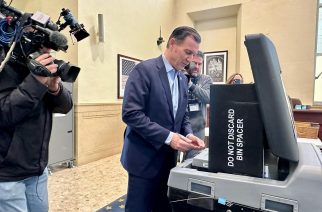
Dr. Howard Freed speaks to the press about the new PFOA questionnaire. Researchers are conducting a survey to gather additional data on illnesses linked to PFOA exposure. He is joined by Judith Enk, a former administrator with the EPA, and Professor David Bond of Bennington College
Former EPA administrator Judith Enck is leading an effort to identify the effects of chemically contaminated drinking water.
At a press conference Tuesday, Enck, who also served as Secretary of the Environment under Eliot Spitzer, pointed to the fluorine containing chemical, PFOA or perfluorooctanoic acid, that has been produced by local manufacturing companies and is linked to a number of life threatening diseases.
A questionnaire is being circulated in order to collect health data and find out who is sick in the Rensselaer County towns of Hoosick Falls and Petersburg as well as Bennington, Vermont.
The survey, which she calls “citizen science,” is being used to identify whether consumers of the local water in those communities have been affected by illnesses including thyroid disease, kidney cancer and ulcerative colitis as well as high blood pressure during pregnancy. Researchers are asking that the questionnaire be competed and returned by October 1.
Enck is hoping citizens can help identify trends and patterns in illnesses in the area. Residents are urged to meet with their physicians and get their blood tested for the linked diseases as well as exposure to PFOA.
“Just to demonstrate its toxicity, eight companies that manufactured PFOA entered into a voluntary agreement with the EPA to stop manufacturing it, effective December 2015,” said Enck, “It is unusual for companies to acknowledge the environmental and public health risks of their chemicals.”
Saint Gobain Performance Plastics in Hoosick Falls, Taconic Plastics in Petersburg and the ChemFab plant in North Bennington, Vermont have all been identified as the sources of contamination in the private wells and local water supplies. Parts of Hoosick Falls were recently named Superfund sites, which will make more resources available for the clean-up process. The Superfund program manages the past contamination and toxicity removal from the site, but does little to address the ongoing health issues of the residents.
“I want to point out that the Superfund statutes do not deal with health problems that individuals may be experiencing,” said Enck. Carbon filters have been made available to residents of the freshly stamped federal Superfund site, Hoosick Falls, which can effectively prevent the health hazards posed by PFOA if maintained properly.
In 2016 the state Department of Health mandated surveys and blood testing of Hoosick Falls residents concluding that PFOA exposure was not linked to cancer in the area. In the reported findings the DOH said they will revisit the data in three to five years to potentially identify any cancer profile changes or emerging trends.
In response to questions pertaining to the DOH Cancer Incidence Investigation, Enck refused to criticize the study but said that they hope to have the DOH’s support if the questionnaire’s results point to a trend in illnesses other than and including cancer. It was made clear that the new survey was not an epidemiological health study, however, in the event of an identifiable trend, a health study would soon follow.
Professor David Bond, the associate director of the Center for Advancement of Public Action at Bennington College, is involved in researching the effects of PFOA in the Northeast. “We’ve analyzed everything from maple syrup to kitchen faucets,” said Bond.
Bond and his colleagues have reached out to the community and fielded the concerns of residents. “I’ve been in hundreds of homes in Hoosick Falls and I’ve heard of the toxic uncertainty PFOAs have introduced into their lives,” said Bond, “So many mothers and fathers have expressed fear and outrage that the homes they’ve labored for years to call their own may have been quietly causing harm to their families all along.”

The Hoosick Falls questionnaire resembles a prominent PFOA study that was conducted in the Mid-Ohio River Valley. Operating from 2005 through 2013, a panel of epidemiologists, assembled by the “parties to the legal settlement of a case between plaintiffs and DuPont,” tested to identify individuals who may have been affected by the release of PFOA emitted since the 1950’s by the Washington Works Plant in Parkersburg, West Virginia.
The chemical compound PFOA contains eight carbon atoms and was commonly referred to as C8 by scientists involved in the study. Cited by Dr. Howard Freed at the press conference on Tuesday, the epidemiologists of the C8 Science Panel observed 65,000 exposed residents and found the developments of six prevalent diseases.
The C8 Science Panel reported in 2012 that “there was a probable link between PFOA and diagnosed high cholesterol, ulcerative colitis, thyroid disease, testicular cancer, kidney cancer and pregnancy-induced hypertension.”
Enck, Freed, Bond and the researchers at Bennington College are asking residents if they have been diagnosed with those same illnesses.
“We thought it was important to directly talk to the residents. This is a different approach, this is citizen science, it’s going directly to people who have been drinking contaminated water and I see this as a supplement to what the Department of Health has already done,” said Enck, “The DOH is certainly free to do more and they certainly have more resources.”
The group is reaching out to former residents through social media and alumni associations to obtain a larger data set.
Residents of the three areas can find the questionnaire here.









